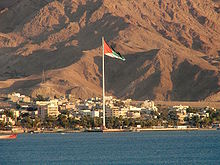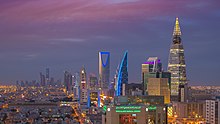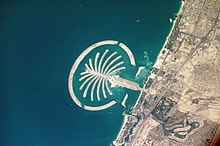Economy of the Middle East
[11] According to Bayt.com's Middle East Consumer Confidence Index, March 2015:[needs update] While close to a quarter (24%) of respondents indicated that their country's economy had improved over the previous 6 months, over one third (35%) thought that it had gotten worse.
Bahrain has also positioned itself as a strong player in Islamic banking in an effort to expand beyond resource exports and into a greater role in the international service industry.
The nature of the state-driven economy has led to significant brain drain in recent years as educated Iranians seek opportunities abroad.
Industries, including the automotive, telecommunications, agriculture, petrochemical, mining, steel, iron, copper, banking and insurance, financial mediation and others trade shares at the Tehran Stock Exchange, which makes Iran unique in the Middle East.
has been commensurate with Western developed nations as is its per capita GDP (PPP), which is about $35,000/year – the third highest (behind Bahrain and the UAE) of the Middle Eastern countries not dependent on natural resources.
"[32] Much of the growth in the country's economy over the past couple of decades is attributable to the software, biomedical, electronics, telecommunications and other high-technology sectors as the percentage of Israelis engaged in scientific and technological inquiry, and the amount spent on research and development (R&D) in relation to gross domestic product (GDP), is among the highest in the world.
Jordan heavily depends on its highly skilled workforce in the oil-rich Persian Gulf to send back money to help support thousands of Jordanian families.
][citation needed] Tourism, ICT, trade, and future oil shale and uranium exports will form the backbone of Jordan's economy.
[39][needs update] 57% of Kuwait's GDP comes from non-oil industry (mostly business services, manufacturing, retail trade, financial institutions, construction, transport and real estate).
At that time Lebanon had the highest in GDP per capita after 6 Gulf Cooperation Council (GCC) state members and Israel, as per the CIA World Fact Book.
Beirut is regaining its place as a financial center of the Middle East with foreign investment returning in all sectors, encouraged by steady growth.
[47] To take its first steps in economic independence it has signed a Free Trade Agreement with the United States and is seeking to do the same with the European Union, China, and Japan.
Following Dubai's increasing role in being a safe haven for the investment of illicit funds and provision of financial secrecy to people behind it – as disclosed under other ICIJ probes such as FinCEN Files and Luanda Leaks – has led to the introduction of the beneficial ownership law in the UAE.
According to ICIJ, companies not abiding by the law and failing to report beneficial ownership information will have to bear administrative penalties and fines worth approximately 100,000 UAE dirhams, starting July 1, 2021.
However, considering the lack of a centralized register to track all financial activities, loopholes, and exemptions in the UBO law itself, advocates believe that it isn't enough as a standalone to control money laundering in UAE.
[91] The reliance on foreign labor markets proved disastrous following the 1991 Persian Gulf War when Saudi Arabia and Kuwait expelled Yemeni workers and curtailed aid to the country in response to its support of Iraq.
On 3 November 2018 a British MP from Labor Party blamed Iran backed rebels in Yemen for the disastrous humanitarian crisis in that country.
When compared to the Levant region (16%) and North Africa (19%), significantly more respondents in the GCC (40%) thought that their country of residence is a more attractive job market.
[93] Following the oil boom of the 1970s, Middle Eastern economies have implemented several reform policies aimed at sustaining economic growth and increasing participation at the macroeconomic level.
These are hoped to help the region reach its full economic potential and to sustain the stability of countries that have accomplished higher rates of growth and development.
The OPEC embargo was directed at the United States and other countries (the Netherlands, Portugal and South Africa), in retaliation for their financial aid and support of Israel during the Yom-Kippur War.
[97][better source needed] The embargo was also prompted by the decision of President Richard Nixon to take the United States off the gold standard, hurting oil-producing countries which collected revenue in US dollars.
[98] In addition to experiencing economic growth, the Middle East also made improvements in development indicators such as infant mortality and life expectancy, and a decrease in unemployment across most sectors.
Following the oil boom and the OPEC embargo of the 1970s, the Middle East became a heavily integrated region in terms of economic growth and employment.
During the 1990s the Gulf Cooperation Council (GCC) countries (Saudi Arabia, United Arab Emirates, Bahrain, Kuwait, Oman and Qatar) were becoming increasingly vulnerable to oil-price volatility.
Beginning in 2010, six countries in the Middle East (Iran, Yemen, Jordan, Tunisia, Morocco and Egypt) made significant reforms to their price subsidies system.
The effectiveness is dependent on many different factors such as the political climate during the time of the reform or whether or not the public receives precautionary warnings and advice in regards to coping with the removal of subsidies from goods and services.
The reduction of subsidies in the Middle East is an ongoing challenge, but has developed significantly though there are often setbacks as they remain susceptible to changes in regime, political conditions, and socioeconomic factors.
Abu Dhabi (capital of the United Arab Emirates) has set goals for achieving an increasingly global and diversified economy by 2030, funded with the city's acquired oil wealth.
As of January 2016, Saudi Arabia and the United Arab Emirates announced the plan to implement value-added tax (VAT) in the GCC as a response to the decrease in oil prices beginning in 2014.














